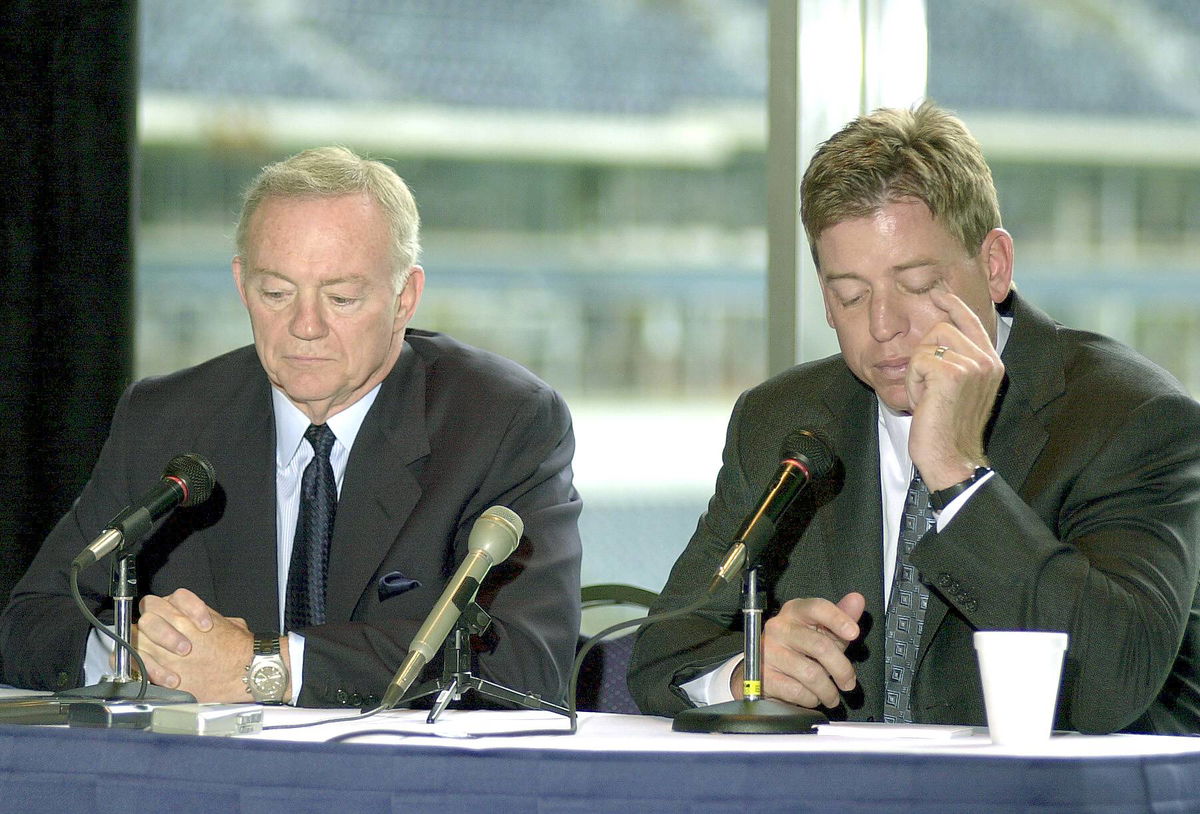
Imago
Bildnummer: 02476847 Datum: 22.03.2001 Copyright: imago/UPI Photo Troy Aikman (re.) gibt gerührt seinen Rücktritt vom Profisport bekannt, daneben Teambesitzer Jerry Jones (beide USA / Dallas Cowboys) – PUBLICATIONxINxGERxSUIxAUTxHUNxONLY (dal2001040904); Vdig, quer, close, Mikro, Mikros, Mikrofon, Mikrofone, Eigentümer, Inhaber, Besitzer, Eigner, Owner, Teameigner, Teamowner, Emotionen, Träne, Tränen, weinen, Rührung, Augen zu geschlossen, traurig NFL 2001, Pressekonferenz, PK, Pressetermin, Karriereende, Karriere Ende, Abschied Dallas Nachdenklichkeit, American Football Herren Mannschaft USA Gruppenbild pessimistisch Randmotiv Personen

Imago
Bildnummer: 02476847 Datum: 22.03.2001 Copyright: imago/UPI Photo Troy Aikman (re.) gibt gerührt seinen Rücktritt vom Profisport bekannt, daneben Teambesitzer Jerry Jones (beide USA / Dallas Cowboys) – PUBLICATIONxINxGERxSUIxAUTxHUNxONLY (dal2001040904); Vdig, quer, close, Mikro, Mikros, Mikrofon, Mikrofone, Eigentümer, Inhaber, Besitzer, Eigner, Owner, Teameigner, Teamowner, Emotionen, Träne, Tränen, weinen, Rührung, Augen zu geschlossen, traurig NFL 2001, Pressekonferenz, PK, Pressetermin, Karriereende, Karriere Ende, Abschied Dallas Nachdenklichkeit, American Football Herren Mannschaft USA Gruppenbild pessimistisch Randmotiv Personen
It’s easy to romanticize the Cowboys’ 90s dynasty, the rings, the flash, the aura of invincibility under Troy Aikman, Emmitt Smith, and Michael Irvin. But beneath the champagne-soaked confetti was a rot no one in Dallas wanted to touch. You don’t win three Super Bowls in four years without some scars, but in the Cowboys’ case, the bruises weren’t just physical. They were tabloid fodder, FBI investigations, and locker room fractures that never fully healed. As Aikman later admitted to Sports Illustrated, “We had some guys who weren’t real fond of me. I was more focused on football, they were focused on other things”. That “other things” was the Cowboys’ dirty open secret.
Watch What’s Trending Now!
And for decades, that secret lived in the shadows of the franchise’s glory. Until now. Charlotte Jones, the Cowboys’ Executive Vice President and daughter of Jerry Jones, is finally breaking her silence on the scandal that trailed America’s Team like a bad hangover. Her rare insight cuts through the years of speculation and half-truths that even Jerry himself has sidestepped, including the infamous White House, a private residence near the team’s facilities that became a symbol of the Cowboys’ off-field chaos. Because while the Cowboys of the 90s defined swagger on Sundays, what went down between the parades left a stain no amount of silver and blue could ever bleach.
On being asked about one of the low points that threatened the Cowboys’ empire by host Emily Tisch Sussman on the podcast ‘She Pivots’, Charlotte Jones didn’t blink. “I probably think the most visible low point — because we’ve had a few — in the mid-nineties, we had a whole lot of success and we had just come off of three big Super Bowl wins,” she said on the America’s Sweethearts podcast. “And then one of our players made a really unfortunate decision off the field and it totally impacted the brand.” She doesn’t name names. She doesn’t have to. Anyone who cracked open Jeff Pearlman’s Boys Will Be Boys: The Glory Days and Party Nights of the Dallas Cowboys Dynasty knows the filth that ran parallel to the football. From Charles Haley’s locker room situation to Michael Irvin’s notorious run-ins, Dallas was a scandal generator on autopilot.
ADVERTISEMENT
That’s why when the headlines broke, Jerry Jones didn’t just see a PR nightmare. “My dad came to me and said, well, how can we counter this conversation… what can we do as an organization to elevate who we are in the midst of this negativity,” Charlotte recalled. That conversation gave rise to a pivot that still defines the Cowboys’ off-field brand. Jerry’s directive? Find a cause, something that could reframe the public perception of a team seen as more nightclub than NFL dynasty. “His comment was, you know, I want to be — this organization should be — the Jerry Lewis of something,” she said. Referencing the late comedian’s iconic telethons for the Muscular Dystrophy Association. That search led Charlotte to the Salvation Army. Partnering with executives like the then-CEO of Frito-Lay to craft a community initiative big enough to drown out the noise.

Imago
NFL, American Football Herren, USA Washington Commanders at Dallas Cowboys Jan 5, 2025 Arlington, Texas, USA Dallas Cowboys owner Jerry Jones before the game against the Washington Commanders at AT&T Stadium. Arlington AT&T Stadium Texas USA, EDITORIAL USE ONLY PUBLICATIONxINxGERxSUIxAUTxONLY Copyright: xKevinxJairajx 20250105_krj_aj6_0000326
However, no amount of charity or rebranding could fully erase the sins of that era. Even head coaches played their part. Jimmy Johnson famously turned a blind eye to the madness as long as the wins piled up. The rot was systemic. Meanwhile, on the field? The Cowboys had turned unstoppable. But fast forward to today? The Cowboys are no longer the dynasty they once were. The scandals may have faded, but so has the winning, and that might be the stain no rebrand can scrub.
ADVERTISEMENT
The great wall of Dallas — built from scraps
The Cowboys’ early 90s dynasty wasn’t just about the Triplets, Troy Aikman, Emmitt Smith, and Michael Irvin got the spotlight, but the true backbone of those Super Bowl runs was the offensive line. NFL Films captured this legacy in A Football Life: The Great Wall of Dallas, a deep dive into the six men who made up the most dominant trench unit of their time. Tackles Mark Tuinei and Erik Williams, guards Kevin Gogan and Nate Newton, and center Mark Stepnoski, with John Gesek stepping in for injuries, turned protecting and paving lanes for Smith into a punishing art form. With commentator John Madden himself glorifying Newton’s bulldozing style, these linemen became stars in their own right.
ADVERTISEMENT
What makes their story even more astonishing is that these weren’t top-tier draft picks or prized prospects. They were castoffs and reclamation projects. Third-rounders, seventh-rounders, undrafted free agents, and a player another team discarded as having “eaten himself out of a job.” Yet, under Jimmy Johnson’s ruthless eye for talent, they morphed into a mauling machine. That chemistry wasn’t instant. Aikman took a brutal beating in the early years, including an infamous game where he was sacked 11 times. But once it clicked, the Cowboys’ front five became the immovable force that powered three Super Bowls in four years. It’s why the front office later believed they could keep reloading the line with late-round picks. Well, because they’d done it before, even if fans today see that logic as naive.
But beneath all the dominance were deeply flawed, sometimes dangerous men. Some were described as bullies, others found themselves entangled in drugs and violence after their playing days. One even got tossed from the Pro Bowl for fighting. A rare and notorious badge of dishonor. The line’s legacy, like the Cowboys themselves, is soaked in triumph and tragedy. Free agency and Jimmy Johnson’s departure drained the soul from the team. Johnson took more with him than just his perfect hair; he took discipline and direction. And while legends like Larry Allen emerged later, the Cowboys never quite replicated the brutality and brilliance of that original wall. That line was messy, imperfect, and human. But when it mattered, it was perfect where it counted: between the whistles.
Top Stories
Forced to Leave FOX, Cowboys Legend Troy Aikman Says ESPN Is Like ‘U.S. Government’ & Clearly Distinguishes the Two Networks
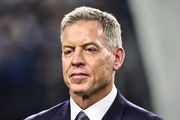
FOX Issues Strict Ban on Terry Bradshaw But NFL Legend Defies It to Join Popular Morning Show
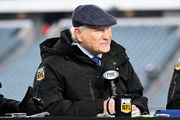
What Happened to T.J. Watt? Why Is He Hospitalized? Steelers Announce Latest News on LB Before Dolphins Game
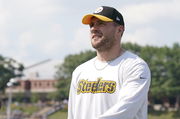
Cowboys Legend Troy Aikman Makes Unretirement Announcement After Airing FOX’s Dirty Laundry
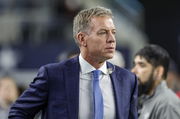
Cam Newton Reveals Exactly Why 32 NFL Teams Blacklisted Him as Panthers Legend Announces Retirement Status
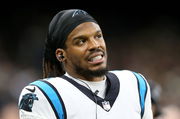
ADVERTISEMENT
ADVERTISEMENT
ADVERTISEMENT

